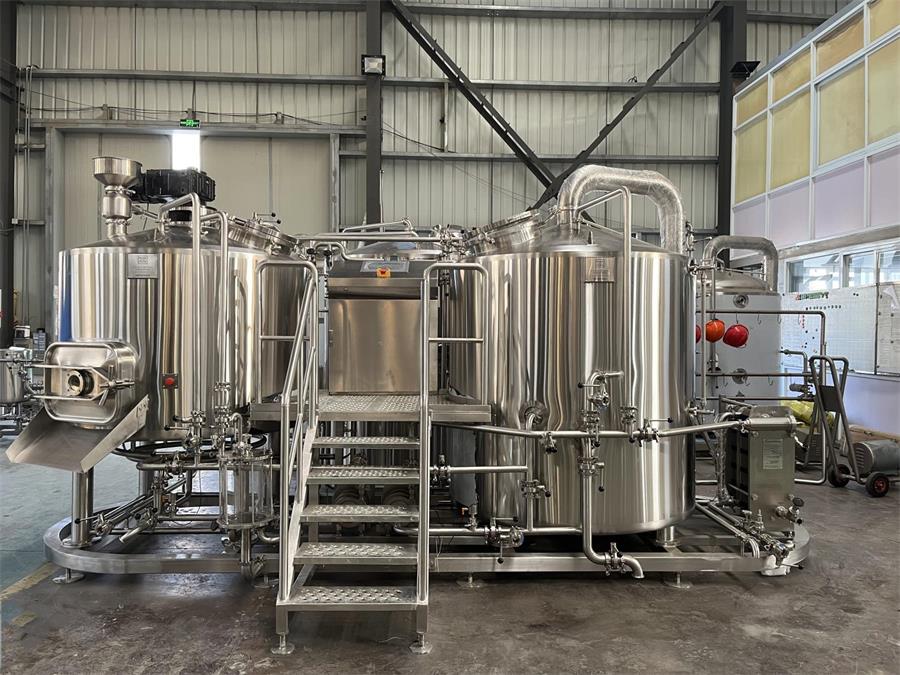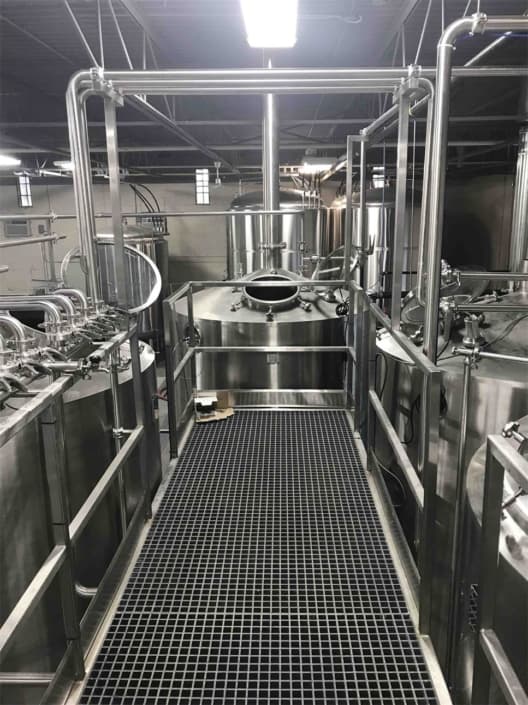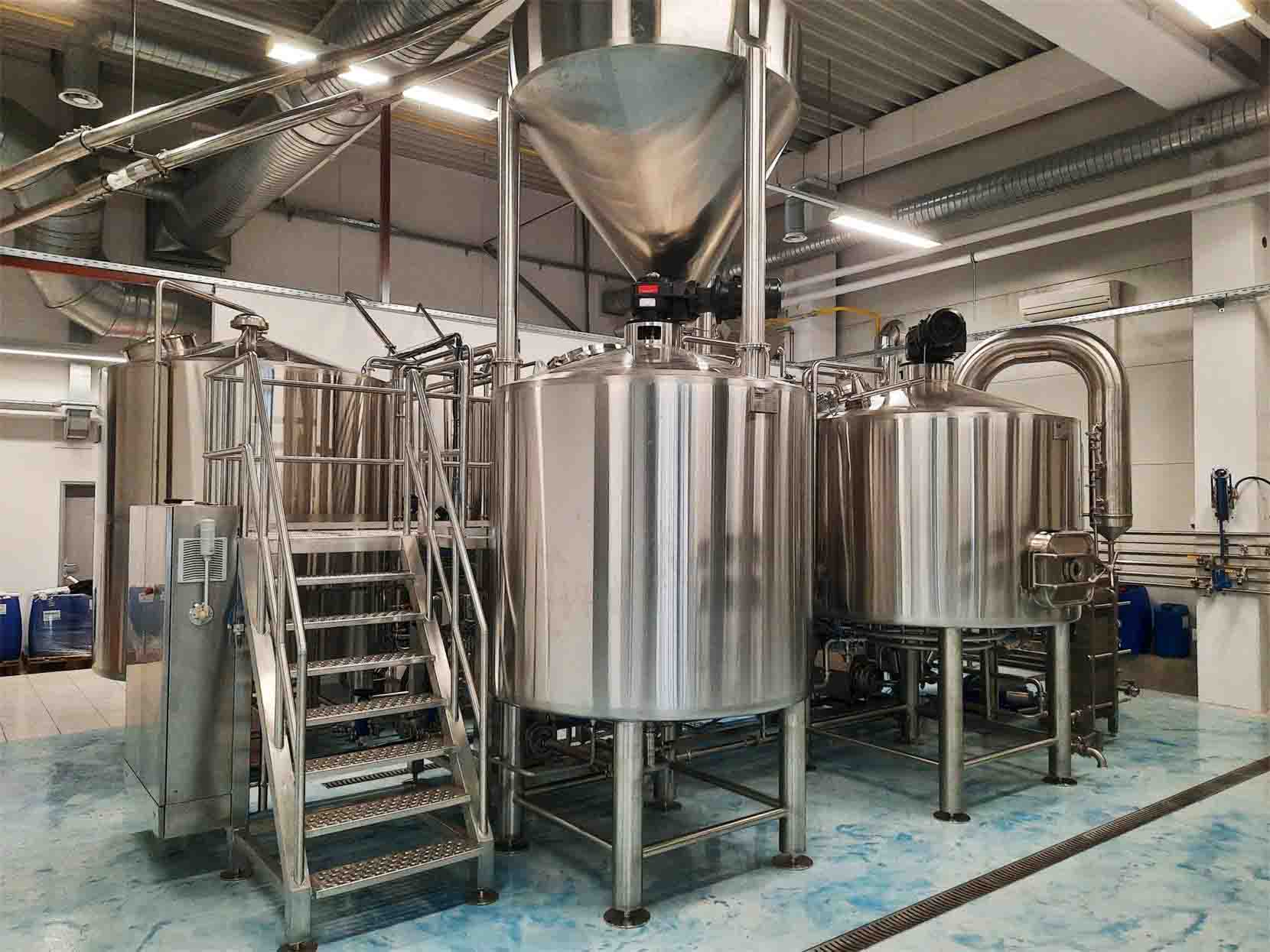Overview of 7 BBL Brewhouse Systems
A 7 barrel (BBL) brewhouse is a medium-sized professional beer brewing system with a capacity to produce 7 barrels or 217 gallons per batch. This brewhouse size is well-suited for small to mid-size microbreweries and taprooms looking to sell beer on premises or distribute locally.
This guide covers key considerations in choosing, designing, installing and operating an efficient 7 BBL brewhouse optimized for your production goals and budget.
Types of 7 BBL Brewhouse Systems
There are two main types of 7 BBL brewhouse systems:
Table: 7 BBL Brewhouse System Types
| System Type | Description |
|---|---|
| Traditional | Manually operated, custom fabricated stainless steel brewhouse vessels with steam heating. Requires an experienced brewer. |
| Automated | PLC-controlled system with pumps, sensors, motors for automation. Program recipes & schedules. Easier to operate. |

7 BBL Brewhouse Brewing Process
A typical brewing process flow through a 7 BBL brewhouse system is as follows:
Milling → Mash Conversion → Lautering → Wort Boil → Whirlpool → Cooling → Fermentation → Conditioning → Filtration → Packaging
During milling, the malted barley grains are cracked open to allow access during mashing. In mash conversion, the grains are steeped in hot water activating enzymes to convert starch into fermentable sugars. The sugary liquid wort is then separated from grains using a lauter tun. The wort then undergoes boiling, whirlpool and cooling before yeast is pitched to ferment the sugars into alcohol and CO2. After fermentation, the green beer is conditioned and filtered before being packaged.
7 BBL Brewhouse Capacity, Design and Customization
When selecting and designing a 7 BBL brewhouse, key considerations include:
Table: 7 BBL Brewhouse Capacity and Design Factors
| Parameter | Details | Customization Options |
|---|---|---|
| Batch Size | 7 barrel (BBL) = 217 gallonsper batch | Custom sized brewhouses from 3–15 BBL |
| Mashing Capacity | 10–14 BBL to allow grains absorption swelling during mashing | Mash filter size, rakes, sensors etc. |
| Boiling Rate | 15-30 gallons per hour boil-off rate | Powerful gas/electric boil kettle |
| Whirlpool Design | Swirl direction, slope, depth for trub separation | Spin cycle customization |
| Temperature Control | Precision sensors & valves for hitting mash, boil, pitch temps | Automated variable speed pumps |
| Recipe Programming | Store recipes with timed temperature steps and valve actuations | Touchscreen HMI, data tracking |
| Brewing Flexibility | Accommodate lagers, ales, specialty beers | Interchangeable vessels, modular design |
| Physical Size | 10-15 ft length x 8-12 ft width x 8-14 ft height | Layout optimization, compact/split design |
| Production Rate | 150-300 BBL per month, 24/7 operation | Semi vs Fully automated, staffing |
Consider the types of beers you wish to produce, ingredients, seasonal variations and packaging to determine the features and functionality needed in your brewhouse early on. An experienced brewhouse manufacturer can help customize the system to meet your specific production goals.
7 BBL Brewhouse Suppliers and Pricing
There is a wide range of brewhouse suppliers, prices and options when investing in 7 BBL systems:
Table: 7 BBL Brewhouse Manufacturers and Costs
| Supplier | Base Price Range | Key Offerings |
|---|---|---|
| Specific Mechanical | $100,000 – $250,000 | Custom manual and automated brewhouses, modular Italian-made |
| Premier Stainless | $150,000 – $300,000 | Traditional custom steam heated kettles & mash tun |
| JV Northwest | $180,000 – $350,000 | Automated touchscreen electric brewhouses |
| Brewmation | $200,000 – $400,000 | Complete automated precision brewing controls |
| AAA Metal Fabrication | $120,000 – $180,000 | Manual systems focused on affordability |
| Evolution Stainless | $250,000 – $450,000 | Integrated eco-friendly steam, electric & solar |
| Psycho Brew | $300,000 – $600,000 | Ultra-modern automated using IoT sensors |
| Craftwerk | $150,000 – $250,000 | German-engineered steam & gas fired kettles |
Prices vary widely depending on level of automation, imported hardware costs, fabrication rates and value-added services offered. Get detailed quotes before deciding on the right brewhouse supplier for your needs.
7 BBL Brewhouse Installation, Operation and Maintenance
Proper installation, operation and preventative maintenance are key to maximizing uptime and keeping your 7 BBL brewhouse running efficiently for years:
Table: 7 BBL Brewhouse Installation and Operation Factors
| Function | Details |
|---|---|
| Installation | Foundation, layout, electrical, plumbing, ventilation, safety, permitting |
| Staff Training | Equipment training on operating procedures |
| Brewing Process | Standard operating procedures for recipes consistency |
| Cleaning & Sanitation | CIP spray balls, chemicals, cleaning schedule |
| Calibration & Alerts | Volume, temperature sensor calibration, tank level alerts |
| Preventative Maintenance | Regular inspection schedule, replace wear items |
| Service & Support | Maintenance contracts, on-call support response time |
Develop detailed standard operating procedures, cleaning regimens, maintenance logs and staff training plans. This ensures smooth operations, consistent quality and minimized unplanned downtime. Partner with your brewhouse manufacturer for continued service and support.
How to Select the Right 7 BBL Brewhouse Supplier
Choosing the optimal 7 BBL brewhouse system for your brewery involves:
Table: How to Evaluate and Select 7 BBL Brewhouse Suppliers
| Consideration | Assessment Criteria |
|---|---|
| Reputation & Experience | Years in business, number of systems installed, client reviews |
| Customization Capabilities | Flexibility to meet specialized requirements |
| Brewing Efficiency & Quality | Precision in hitting temps and timings for yield and taste |
| Ease of Use | Intuitive design and controls for simplicity |
| Service & Support | Response time, availability of parts/service, maintenance plans |
| Value for Investment | Performance, reliability and payback period given costs |
| Local Representation | Installation, commissioning and service partnerships |
Evaluate each brewhouse supplier against these criteria relative to your organization’s priorities using detailed RFPs, reference checks, facility tours and pilot batches. This drives an informed decision balancing custom features, budget and long-term service support.
Comparing Pros and Cons of 7 BBL Automated Brewhouses
Automated brewhouses provide advantages in efficiency, consistency and labor savings – but also carry higher costs and complexity:
Table: Pros and Cons of Automated 7 BBL Brewhouses
| Pros | Cons |
|---|---|
| Precise temperature and timing control | Twice the capital expense of manual |
| Automated cleaning and record keeping | Complex programming and controls |
| Store recipes for perfect repeatability | Require specialized technical support |
| Reduce labor requirements | Potential for costly electronic failures |
| Hands-off remote monitoring | Lengthy troubleshooting procedures |
| Easy scale up with modular expansions | Generally imported hardware markups |
Weigh the benefits against drawbacks smartly based on available capital, staff competencies and brewing goals. Starting semi-automated also provides a middle ground.
Limitations and Considerations of 7 BBL Brewhouse Systems
While 7 BBL brewhouses are efficient small batch setups, be aware of inherent scale and flexibility limitations:
Table: Scaling Challenges with Expanding 7 BBL Brewhouses
| Limitation | Implication | Mitigation Strategy |
|---|---|---|
| Max Batch Size | Limited to peak volumes around 15 BBL per batch | Start with larger 10-15 BBL system |
| Ingredient Handling | Manual grain handlingwon’t keep up with growth | Automate milling, moving and cleaning |
| Packaging Bottleneck | Manual labeling, boxing, palletizingpace constraints | Integrate inline bottling, canning, kegging |
| Refrigeration Capacity | 7 BBL fermentation andbrite tanks max out | Plan modular cold room expansions |
| Steam Boiler Capacity | Eventually hits max steaming rate per hour | Upgrade to 20-30 BBL electric steam generator |
Starting too small risks major investments in upgrades soon. But overbuilding capacity too early carries high costs. Consult experts to define scaling roadmap.

FAQs
Table: Frequently Asked Questions About 7 BBL Brewhouse Systems
| Question | Answer |
|---|---|
| How much can a 7 BBL brewhouse produce annually? | 2,600 to 5,200 barrels per year is typical operating single or 2 shifts daily, assuming good uptime. |
| What size building is needed to house a 7 BBL system? | Allow 15 ft x 15 ft of space for the brewhouse itself. Total building size including fermentation and storage would need to be 2000 to 4000 sq. ft. |
| Can I buy a used 7 BBL brewhouse system? | Yes, buying used can save substantially on costs – but may carry risk of mechanical issues or condition concerns. Inspect carefully before purchase. |
| Should I buy domestic or imported 7 BBL hardware? | Domestic provides ease of service but costs more. Imported cuts expense by 30% but sacrifices convenience and customization. |
| What are the most critical factors in selecting supplier? | Evaluate reputation, quality, serviceability, support capabilities and staff competency above just price alone. |
Additional FAQs About 7 BBL Brewhouse Systems
1) What brewhouse configuration is most efficient at the 7 BBL size?
- For most taprooms, a 2-vessel system (mash/lauter + kettle/whirlpool) balances capex and throughput. If you plan 2–3 turns/day or brew high-adjunct/wheat recipes, a 3-vessel layout (separate lauter) improves lauter speed and consistency.
2) How should I size hot liquor (HLT) and cold liquor (CLT) for 7 BBL Brewhouse Systems?
- Plan HLT ≈ 1.2–1.5× brewhouse size per turn; CLT sized for at least a double-batch knockout. Adjust for groundwater temperature and glycol capacity to prevent chilling bottlenecks.
3) Which utilities are commonly underestimated at this scale?
- Boiler horsepower and condensate return, electrical service for pumps/elements/VFDs, make-up water treatment (softening/RO), floor drains and trench slope, and glycol tonnage with insulated headers.
4) What QA instrumentation offers the best ROI?
- Handheld/inline dissolved oxygen (DO) at brite/pack, calibrated pH/temperature probes, density/ABV meter, dissolved CO2 meter, and basic yeast lab (microscope + hemocytometer). These tighten consistency and reduce returns.
5) What realistic annual output can a 7 BBL system support?
- With 1–2 brewers and moderate automation, 500–1,000 bbl/year is typical. Reaching the upper end requires adequate cellar capacity, CLT/knockout performance, and tight scheduling.
2025 Industry Trends for 7 BBL Brewhouse Systems
- Integrated controls: Entry-level OPC UA-capable PLCs and app-connected PIDs for recipe logging, alarms, and remote checks.
- Utility optimization: Wort-to-HLT heat recovery, VFDs on pumps, and improved insulation lower kWh/hL and water use.
- Oxygen management: Closed transfers, CO2 purged lines, and inline DO at brite/pack extend shelf life for hop-forward beers.
- Pressure-capable cellars: More 2–3 bar unitanks enable spunding, cutting CO2 purchases and improving aroma retention.
- Faster commissioning: Skid-mounted hot-side modules with FAT/SAT documentation shorten install timelines and reduce risk.
2025 Data Snapshot: Adoption and Performance Benchmarks
| Metric | 2022 | 2024 | 2025 (proj.) | Notes / Sources |
|---|---|---|---|---|
| New 7 BBL installs choosing 3-vessel over 2-vessel | 38% | 42% | 45–48% | Supplier surveys; trade press |
| Brewhouses with wort-to-HLT heat recovery | 40% | 48% | 52–58% | OEM application notes |
| Sites measuring DO at brite/packaging | 36% | 44% | 50–56% | Instrument vendor briefs; BA QA talks |
| Average water use ratio with validated CIP (hL/hL) | 5.6 | 5.2 | 4.9–5.1 | BA benchmarking; audits |
| Typical lead time for 7 BBL skids (weeks) | 12–18 | 10–16 | 9–14 | Supplier reports |
Sources:
- Brewers Association Quality & Sustainability: https://www.brewersassociation.org
- Institute of Brewing & Distilling (IBD): https://ibd.org.uk
- ProBrewer vendor forums and directories: https://www.probrewer.com
- OEM technical briefs on heat recovery, CIP validation, and DO measurement
Latest Research Cases
Case Study 1: CLT Upgrade + Heat Recovery Enables 3 Turns/Day (2025)
Background: A taproom brewery running a 7 BBL 2-vessel system struggled to hit 2–3 turns/day due to slow knockouts and rising utilities.
Solution: Installed wort-to-HLT heat recovery, upsized CLT for double-batch knockouts, insulated hot lines, and added VFDs with recipe-linked pump profiles.
Results: Energy intensity down 15–20%; knockout time reduced by ~20 minutes/turn; consistent 3 turns/day achieved for flagship SKUs. Sources: Brewery energy audit; OEM engineering memo.
Case Study 2: DO Control Reduces Returns on Hazy IPA (2024)
Background: Elevated TPO and early staling in 16 oz cans led to customer complaints and discounts.
Solution: Implemented closed transfers, CO2 purging SOPs, inline DO at brite inlet and pack, and spunding in 2-bar unitanks.
Results: Package TPO decreased ~25–35%; 60-day sensory showed improved hop retention; returns fell 17%. Sources: QA logs; Brewers Association Quality session notes.
Expert Opinions
- John Mallett, Brewing Operations Expert; Author of “Malt: A Practical Guide”
Viewpoint: “At 7 BBL, lauter bed management and reliable measurement (pH, temperature, DO) deliver more value than chasing advanced automation. Calibrate first—optimize second.” - Dr. Katherine C. Smart, Professor of Brewing Science; Former Global VP R&D, AB InBev
Viewpoint: “Validated CIP and oxygen control are the foundation of consistent quality. Specify verification—conductivity, temperature, and coverage—not just ‘CIP capable’.” - Bart Watson, Chief Economist, Brewers Association
Viewpoint: “Operational discipline—utilities efficiency and QA—helps small brewers defend margins while competing in a crowded market.”
Source: Brewers Association analyses and talks
Citations:
- Brewers Association Quality and Sustainability resources: https://www.brewersassociation.org
- IBD technical materials: https://ibd.org.uk
Practical Tools and Resources
- ProBrewer calculators and threads on 7 BBL layouts/throughput: https://www.probrewer.com
- G&D Chillers load calculators for CLT/glycol sizing: https://gdchillers.com
- Anton Paar DO/CO2/density instruments: https://www.anton-paar.com
- CIP validation and passivation standards (riboflavin method; ASTM A967): https://www.astm.org/a0967_a0967m-17.html
- BA Sustainability Benchmarking (energy/water KPIs) and Quality manuals: https://www.brewersassociation.org
Note: When specifying 7 BBL Brewhouse Systems, request P&IDs, utility load lists, HLT/CLT sizing rationale, false-bottom geometry, lauter DP/torque specs, heat-recovery options, auto-CIP validation criteria, and FAT/SAT scope. Align cellar capacity (unitanks/brite tanks) and packaging speed with target turns/day to avoid downstream bottlenecks.
Last updated: 2025-09-02
Changelog: Added 5 focused FAQs, 2025 benchmark table, two recent case studies, expert viewpoints, and curated tools/resources aligned to 7 BBL brewhouse needs.
Next review date & triggers: 2026-01-15 or earlier if BA/IBD publish new QA/CIP guidance, OEM lead times/specs shift >20%, or energy/water/DO benchmarks change materially.
Share this entry
Interested in learning more about Brewing Systems including additional details and pricing information? Please use the form below to contact us!
YOLONG BREWERY EQUIPMENT FAQS
- Commercial Brewery / Craft Brewery / Microbrewery / Nanobrewery
- What is The Difference Between Craft Beer and Industrial Beer?
- The Bespoke Differences In Custom Brewing Systems
- Everything You Need to Know About Kettle Souring
- How to Choose Brewing Equipment for Your business?
- How To Choose The-Best Partner To Build Your Commercial Microbrewing System?
- Two Detection Sensors That You Need To Use In Your Brewhouse System
- Remote Control Applications in Brewing Equipment/How does it work?
- How To Clean Your Brand New Brewery Tanks?

